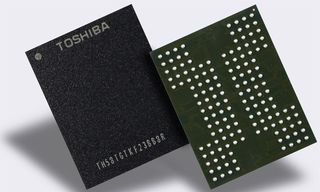Toshiba's QLC flash memory paves path toward cheaper high capacity SSDs
1.5TB SSDs are on the horizon.

Toshiba has developed what it claims is the world's first quadruple-level cell (QLC) 3D NAND flash memory with a stacked cell structure. While that is exciting for Toshiba from a technical standpoint, the upshot for consumers is higher capacity solid state drives at mainstream price levels.
That also means mainstream performance, as is typically the case with SSDs that use triple-level cell (TLC) NAND flash memory. TLC drives usually suffer from inferior write performance, and we suspect that will be the case with QLC-based SSDs, only more so.
The path to QLC was inevitable, though not necessarily easy. Multi-bit flash memory chips store data by managing the number of electrons (the charge) in each individual memory cell. Bumping things up to 4-bit-per-cell (QLC) presented Toshiba with some technical challenges, as increasing the number of bit-per-cell by one requires twice the accuracy of TLC memory. SLC NAND only tracks two voltage states, MLC (2-bits per cell) tracks four voltage states, TLC has eight voltage states, and now QLC has 16 voltage states.
So how did Toshiba work around this? In vague terms, Toshiba said it drew on its advanced circuit design capabilities and 64-layer 3D flash memory process technology to create QLC 3D flash memory. The end result is a prototype that features the world's highest die capacity with that memory process.
Looking ahead, Toshiba says that QLC 3D flash memory will enable 1.5TB SSDs with a 16-die stacked architecture in a single package. At what price point remains to be seen.
"From SLC to MLC and MLC to TLC, large technology shifts are often met by industry resistance and the introduction of QLC is no exception," noted Scott Nelson, senior vice president of TAEC's memory business unit. "There will always be demand for compelling storage solutions that bring higher densities and produce a favorable cost/performance equation—our QLC technology falls squarely into that sweet spot."
Toshiba plans to demonstrate a 1.5TB SSD based on QLC memory during the Flash Memory Summit in Santa Clara, California this August. Hopefully that means we will see consumer solutions by the end of the year.
PC Gamer Newsletter
Sign up to get the best content of the week, and great gaming deals, as picked by the editors.
Paul has been playing PC games and raking his knuckles on computer hardware since the Commodore 64. He does not have any tattoos, but thinks it would be cool to get one that reads LOAD"*",8,1. In his off time, he rides motorcycles and wrestles alligators (only one of those is true).
Most Popular








